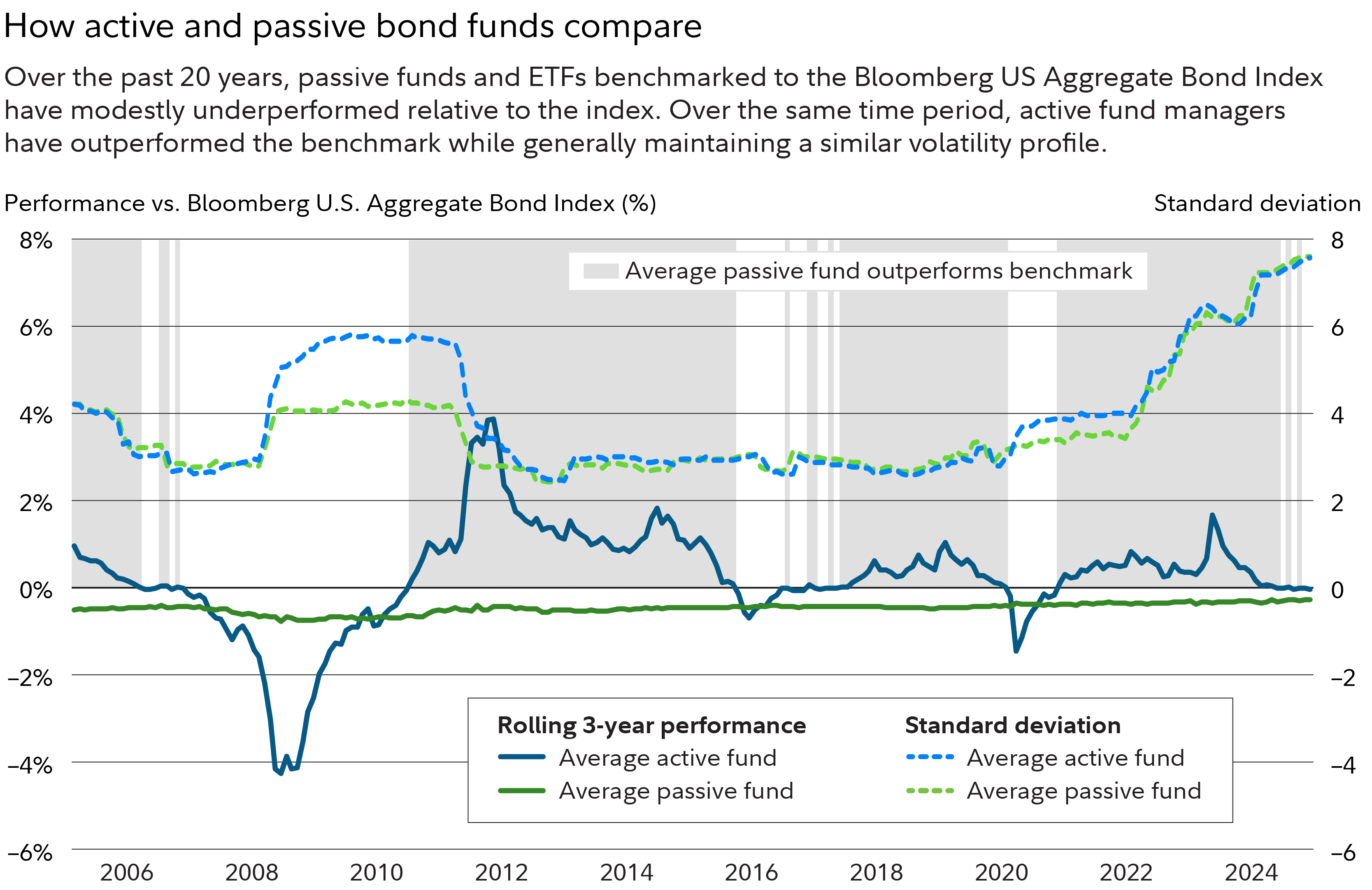Bond mutual funds and exchange-traded funds (ETFs) are a convenient way to add fixed income exposure to your portfolio. They can offer income, diversification, and easy access to your money to help you achieve your investment objectives.
Investors who want to add a bond fund to their portfolio have plenty of options to choose from—and plenty of things to consider when making that choice. One of those considerations is whether to choose an actively managed fund whose professional manager seeks to deliver a higher return than that of an index, or a passive fund that seeks only to duplicate an index’s performance.
While passive funds tend to come with lower expenses than actively managed ones, the latter can offer higher returns after expenses. This is particularly true of bond funds, since the universe of bonds is so much bigger and trading is more complex than with stocks. Indeed, actively managed bond funds have outperformed their benchmarks much more frequently than actively managed stock funds.
What works for stocks may not work for bonds
Many investors find passively managed index mutual funds or ETFs to be good options for stock investing. However, they may also find that actively managed funds can offer significant advantages over passive funds for bond investing.
Stock markets offer investors opportunities to buy or sell shares of a relatively small number of companies and the process of valuing, buying, and selling stocks is efficient. Bond markets, however, are much larger, more complex, and far less efficient. That’s not necessarily a bad thing, but it does suggest that differing investment strategies may be needed in differing markets.
Unlike stock markets where even the most skilled and experienced managers may struggle to outperform popular market indexes such as the S&P 500 over time, the very size, complexity, and inefficiency of the bond markets has historically created opportunities for skilled active managers to outperform popular indexes.
In fact, the majority of active bond managers have outperformed their benchmark indexes over time, sometimes significantly. Meanwhile, passive bond investing strategies have sometimes struggled to deliver performance that matches their benchmark indexes because broad-based fixed income indexes are more difficult to replicate than stock indexes are. Remember, though, that past performance is no guarantee of future results.

Active bond managers have more opportunities
It's important to understand how big the bond market really is to understand the importance of active management. A stock market index such as the S&P 500 can provide easy exposure to the biggest—and often most attractive—stocks in the market and a passive strategy that tracks it can give an investor exposure to a meaningfully large group of stocks.
By comparison, the investible universe of bonds is so large and diverse that even a broad-based index such as the Bloomberg US Aggregate Bond Index (often referred to as the Agg) can only reflect a relatively small portion of the market.
The Agg contains more than 25 times the number of securities as the S&P, but that still represents just a sliver of the $58 trillion bond market according to the Securities Industry and Financial Markets Association (SIFMA) that an active manager can invest in. That means if you choose an index fund that seeks only to track the Agg, you’ve effectively put most of the potential opportunities in the bond market off limits.
What’s in your index?
While the securities in an actively managed bond portfolio are all there because an experienced manager believes they offer opportunities, the securities in a passive index-tracking bond strategy simply reflect what is in a portion of the market, which may not always be what you want.
Unlike a stock index which will always contain stocks issued by companies, the composition of an index like the Agg that includes a much more diverse variety of assets may change significantly over time. Those changes can have a meaningful impact on the performance and characteristics of the index. For example, US Treasury bonds made up 35% of the Agg in 2014. By 2024 however, they accounted for 44% of its value. The change resulted not from a manager seeing an opportunity in Treasurys but from the government issuing more bonds as deficit spending increased. Over that time period, a passive index-tracking fund would have increased its exposure to Treasurys to match the changing composition of the Agg, likely changing the return and risk characteristics of the portfolio over that time.
How active bond managers manage
The size, complexity, and inefficiency of bond markets mean they often don’t value bonds in ways that everybody agrees on. As a result, sometimes some bonds may be priced higher—or lower—than their fundamental characteristics suggest they should be. Active managers can create value for the investors in the funds they manage by looking for mispriced bonds, buying the underpriced bonds and selling the overpriced bonds. In contrast, passive funds can’t consider valuations and fundamentals, they can only seek to replicate the composition of an index.
Active managers can do this because unlike passively managed funds, they can analyze a wide variety of factors and choose which bonds to buy and which to sell in an effort to outperform the index. They can draw on expert researchers and traders to sort through the unique characteristics of bond markets and discover attractive investment opportunities that passive strategies miss.
Besides being able to research, buy, and sell a wider range of bonds than a passive strategy can, active bond fund managers also have the flexibility to change some important characteristics of the portfolios they manage to potentially enhance total return (the return generated from both interest income and capital appreciation from rising bond prices).
For example, because bond prices fluctuate as interest rates change, a changing rate environment can have a significant impact on a fund’s total return. While a passive fund must reflect the composition of its benchmark index, regardless of how rates move, an active manager can use research and trading resources to help reposition a portfolio to seek to take advantage of changing rates and manage the volatility which can accompany rate moves.
For example, if a rate hike by the Federal Reserve were to push bond prices—and the Agg—down, a passive fund would simply track the index and move lower, hurting the value of an investor's portfolio. However, an active manager may be able to cushion the impact of the rate hike by buying bonds with shorter maturities that tend to be less sensitive to changing rates and avoiding others that are more likely to fall in price when rates rise.
Finding ideas
If you’re interested in adding an actively managed bond fund to your portfolio, Fidelity’s research tools can help you choose a fund that aligns with your goals. Here are some questions to consider as you research funds:
- Do you want a mutual fund or an ETF? Each has its own advantages and one may be more suitable for you than the other.
- Does a manager have the resources to find market inefficiencies, analyze the risks, and buy and sell bonds efficiently?
- Do the potential returns and risks of the fund align with your objectives? For example, if your goal is to diversify a portfolio of stocks, you might prefer a strategy with lower historical correlations to stocks.
- How much risk is a manager taking? If a manager is earning higher returns by investing in riskier bonds, you might consider whether the returns are worth the extra risk.
- Where is risk coming from? Two risks in a bond fund are the possibility that bonds will default (credit risk) and sensitivity to interest-rate changes (duration). An active bond fund’s level of credit risk and a duration target can be set by the manager so you may want to understand how and why the risks differ from those of the benchmark index.
- How much flexibility does the manager have in choosing the sector, credit quality, and interest-rate sensitivity of the holdings? An investor seeking diversification may prefer different guidelines than an investor seeking income.
- How are investment decisions made and monitored at the firm managing the fund? What incentives are put in place to maintain appropriate risk levels?
You can run screens using the fund screener and ETF Evaluator on Fidelity.com. Below are the results of some illustrative screens for Fidelity active bond funds and ETFs, as of January 15, 2025. (These are not recommendations of Fidelity).
Active bond funds
Fidelity® Total Bond Fund (
Fidelity® Corporate Bond Fund (
Fidelity® Investment Grade Bond Fund (
Fidelity® Limited Term Bond Fund (
Active bond ETFs
Fidelity® Total Bond ETF (
Fidelity® Corporate Bond ETF (
Fidelity® Investment Grade Bond ETF (
Fidelity® Investment Grade Securitized ETF (
Fidelity® Limited Term Bond ETF (
The Fidelity screeners are research tools provided to help self-directed investors evaluate these types of securities. The criteria and inputs entered are at the sole discretion of the user, and all screens or strategies with preselected criteria (including expert ones) are solely for the convenience of the user. Expert screeners are provided by independent companies not affiliated with Fidelity. Information supplied or obtained from these screeners is for informational purposes only and should not be considered investment advice or guidance, an offer of or a solicitation of an offer to buy or sell securities, or a recommendation or endorsement by Fidelity of any security or investment strategy. Fidelity does not endorse or adopt any particular investment strategy or approach to screening or evaluating stocks, preferred securities, exchange-traded products, or closed-end funds. Fidelity makes no guarantees that information supplied is accurate, complete, or timely, and does not provide any warranties regarding results obtained from its use. Determine which securities are right for you based on your investment objectives, risk tolerance, financial situation, and other individual factors, and reevaluate them on a periodic basis.



